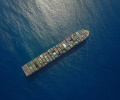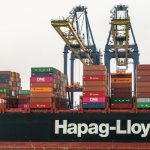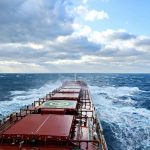The Board of Directors of d’Amico International Shipping S.A. (Borsa Italiana: “DIS”) (hereinafter: “the Company”, “d’Amico International Shipping” or the “Group”), a leading international marine transportation company operating in the product tanker market, today examined and approved the Company’s first quarter 2023 consolidated financial results.
MANAGEMENT COMMENTARY
Paolo d’Amico, Chairman and Chief Executive Officer of d’Amico International Shipping commented:
‘I am pleased to report DIS’ consolidated financial results for the first quarter of 2023, in which we achieved a very strong Net profit of US$ 54.1 million (or US$ 56.5 million excluding some non-recurring items) compared with a Net loss of US$ (6.5) million recorded in Q1’22.
The product tanker market has remained very strong in recent months, though with significant volatility. In fact, Clarksons has recently estimated current fleet capacity utilization at 91%, and with such tightness, even minor temporary or regional changes in demand can have a significant impact on short-term spot market rates. DIS achieved a daily spot TCE rate of US$ 36,652 in the first quarter of the year vs. US$ 12,857 in Q1 2022. At the same time, DIS had 25.2% of its employment days covered at an average daily TCE rate of US$ 26,367 in Q1 2023 (Q1 2022: 44.5% coverage at an average daily rate of US$ 14,968). Thus, the Company achieved a total blended daily TCE (spot and time-charter) of US$ 34,056 in Q1 2023, compared with US$ 13,796 achieved in Q1 2022. Last year, DIS intentionally refrained from increasing its contract coverage, to increase its spot exposure in a rapidly rising market with strong fundamentals. This has proven to be the right strategy so far and we are now gradually increasing our coverage at very attractive levels.
In the first quarter of the year, oil demand expanded by approximately 0.8 million b/d (q-o-q), mainly thanks to the reopening of the Chinese economy. According to IEA’s April report, global oil demand will grow by almost 2.7 million b/d between Q1 and Q4 2023, reaching 103.0 million b/d in the last quarter of the year (2.4 million b/d more than in Q4 2019). China’s demand growth is expected to account for approximately 57% of the estimated global gains in the year. In addition, according to the IEA Jet fuel will be the largest source of oil demand growth in 2023 (+1.2 million b/d and +19% year-on-year), reaching 7.3 million b/d, equal to approximately 90% of 2019 levels. In the first three months of 2023, the product tanker market was negatively affected by refinery maintenance activity in the US, which started earlier than usual, mainly due to the impacts of the freezing temperatures experienced at the end of 2022. However, according to a recent outlook issued by the EIA, crude runs should increase by 3.1 mb/d between March and August ’23 thanks to the normalization of US throughput and materially higher Chinese volumes. Also, we have recently noticed a decline in refining margins, which we believe is only temporary as the rapid increase in oil consumption expected in the rest of the year, is likely to lead to a recovery in refining profitability from Q3 onwards. On 5 February 2023, the EU sanctions and associated price cap on Russian oil product exports came into force and started to have an impact on the product tanker market towards the end of the quarter. Therefore, Russian exports to Europe have collapsed and those to Asia (Singapore, India, and China), Africa, Turkey, Brazil, and Middle East, have surged. Disruptions to trade flows due to the rerouting of Russian oil to new more distant destinations have significantly increased oil in transit. In fact, shipments from Western Russia to Northwest Europe took around 10 days, while voyages to India and China take approximately 30 to 40 days, respectively.
The underlying fundamentals for our industry remain very supportive. The secular dislocation of refinery capacity further away from key consuming centres (Europe, USA, Australia) to mainly the Far and Middle East, will be extremely beneficial for product tankers’ ton-miledemand. In addition, tonnage supply growth is expected to be very limited in the coming years and in the segments we operate in (MRs and LR1s), currently estimated by Clarksons at only 0.6% for 2023 (after a very modest 1.4% increase in 2022), amongst the lowest levels ever recorded. Also, according to Clarksons, as at the end of March 2023, 8.3% of the MR and LR1 fleet was over 20 years old (in dwt), 36.9% was more than 15 years old, whilst the current order book in these segments represented only 4.2% of the current trading fleet. Whilst ordering activity has recently increased (mainly in the LR2 segment), market players remain extremely reluctant to order given the increase in new building costs and limited yard availability, with vessels ordered today likely to be for delivery only in H2 2025. In addition, the expected technological change required to meet the increasingly demanding environmental regulations (EEXI and CII, in particular) is further reducing the appetite for new buildings, since such vessels could be obsolete soon after delivery. These new regulations could lead to a further acceleration in the scrapping of old, less efficient tankers and might force some of these vessels to slow-steamto reduce emissions.
In the first quarter of the year, DIS continued to pursue its deleveraging plan, mainly through the gradual exercise of the remaining purchase options on our bareboat chartered-in vessels. I am very proud to report that at the end of March ’23, the ratio between our net financial position (excluding IFRS 16) and our fleet market value ratio was of only 27.2% vs. 72.9% at the end of 2018. As we stated several times, we consider a solid financial structure and a low breakeven pillars of our strategy, given the highly cyclical and capital-intensive nature of our business.
As we look with optimism to the next quarters, with a solid Company, a modern fleet, and a highly skilled and motivated team, I would like to thank our Shareholders for their continued trust and support.’
Carlos Balestra di Mottola, Chief Financial Officer of d’Amico International Shipping commented:
‘In the first quarter of 2023, DIS posted a consolidated Net profit of US$ 54.1 million vs. a Net loss of US$ (6.5) million recorded in the same period of last year. Our adjusted net result (excluding results on disposals and non-recurring financial items, as well as asset impairments, from both periods) was of US$ 56.5 million in Q1 2023, compared with US$ (4.0) million in the same quarter of the prior year.
In detail, DIS achieved a daily spot TCE rate of US$ 36,652 in Q1’23 vs. US$ 12,857 in Q1’22, whilst our period contract coverage was equal to 25.2% of our vessel days at a daily average TCE rate of US$ 26,367. Therefore, our total daily average TCE rate (which includes both spot and period contracts) was of US$ 34,056 in Q1 2023 vs. US$ 13,796 in Q1 2022.
In the first three months of 2023, we achieved an EBITDA of US$ 76.4 million vs. US$ 17.8 million in Q1 2022, which together with a positive trend in working capital, led us to generate US$ 99.2 million in operating cash flow, compared with US$ 10.2 million in the same quarter of 2022.
Thanks to the strong freight markets of 2022 and to the significant deleveraging plan implemented in the last few years, through vessel disposals and equity capital increases, DIS can now benefit from a very solid financial position. As at the end of March 2023, DIS had a Net Financial Position (NFP) of US$ 316.1 million and Cash and cash equivalents of US$ 155.2 million vs. a NFP of US$ 409.9 million at the end of 2022. DIS’ NFP (excluding IFRS16 effects) to FMV ratio was of 27.2% at the end of Q1 2023 vs. 36.0% at the end of 2022 and 72.9% at the end of 2018. As previously communicated, we are currently executing on our plan to gradually exercise the remaining purchase options on our bareboat chartered-in vessels, with the objective of further deleveraging our balance sheet and lowering our breakeven.
In addition to having already substantially reduced our financial leverage, we have almost no refinancing risk in the next years, as only a small portion of our bank debt matures in 2025, whilst the loans which were due to mature in 2023 have already been refinanced at very competitive terms. The only balloon which was due to mature in 2024 was instead prepaid last April and should be refinanced in Q3 this year.
DIS has no remaining newbuilding CAPEX, having fully completed its US$ 755 million long-term investment plan in eco newbuilding tankers, in 2019. In 2023, DIS’ investments relate to the exercise of the purchase option for the M/T High Explorer (a time-chartered-in vessel which we expect to be delivered to us in May) for a consideration of US$30.0 million, as well as to US$ 14.5 million for maintenance purposes, including the installation of scrubbers on two of our vessels.
Thanks to DIS’ financial strength, our proven commercial strategy and a modern and mainly ‘eco’ fleet, as well as to the positive prospects for our industry, I’m confident we will continue to generate significant positive returns for our Shareholders in the coming quarters and years.’
FINANCIAL REVIEW
SUMMARY OF THE RESULTS IN THE FIRST QUARTER 2023
The product tanker market has remained strong so far in 2023, though with significant volatility and on average slightly below the very firm levels seen at the end of 2022.
The reopening of the Chinese economy from COVID lockdowns has contributed to an acceleration in oil demand growth, which expanded by 810 thousand b/d in the first quarter of 2023. However, the higher Chinese domestic demand also affected product exports which declined by 20% in March relative to the previous month, although still 39% higher year-on-year. The product tanker market in the first few months of 2023 was also negatively affected by refinery maintenance activity in the US, which started earlier than usual, because of the impacts on the sector from the freezing temperatures experienced towards the end of 2022. The refinery turnarounds were also more extensive than usual because some units had delayed maintenance in the fall of 2022 due to the exceptionally strong markets at the time. A big ramp-up in refining activity in the US is expected from April to June ’23.
The official EU sanctions on Russian exports, which came into force on 5 February ’23, started impacting the market towards the end of the first quarter, with exports to the EU collapsing and those to Turkey (+130 thousand b/d m-o-m in March), the Middle East (+350 thousand b/d m-o-m in March), Africa (+320 thousand b/d m-o-m in March) and Latin America (+80 thousand b/d m-o-m in March), increasing sharply. The resulting increase in ton-miles is expected to be beneficial for the product tankers market.
The one-yeartime-charter rate is always the best indicator of spot market expectations and as at the end of March 2023 was assessed at around US$ 31,250 per day for a conventional MR2, with an Eco MR2 assessed at a premium of around US$ 3,000 per day.
In Q1 2023, DIS recorded a Net profit of US$ 54.1 million vs. a Net loss of US$ (6.5) million posted in the same quarter of 2022. Such positive variance is attributable to an improved product tanker market relative to the same period of last year. Excluding results on disposal and non-recurringfinancial items, as well as the asset impairment, DIS’ Net result would have amounted to US$ 56.5 million in Q1 2023 compared with US$ (4.0) million recorded in Q1 2022.
DIS generated an EBITDA of US$ 76.4 million in Q1 2023 vs. US$ 17.8 million achieved in Q1 2022, whilst its operating cash flow was positive for US$ 99.2 million in Q1 2023 compared with US$ 10.2 million generated in the same quarter of last year.
In terms of spot performance, DIS achieved a daily spot rate of US$ 36,652 in Q1 2023 vs. US$ 12,857 in Q1 2022, due to the much stronger market relative to the same period of last year.
At the same time, 25.2% of DIS’ total employment days in Q1 2023, were covered through ‘time-charter’ contracts at an average daily rate of US$ 26,367 (Q1 2022: 44.5% coverage at an average daily rate of US$ 14,968). A good level of time charter coverage is one of the pillars of DIS’ commercial strategy and allows it to mitigate the effects of the spot market volatility, securing a certain level of earnings and cash generation even throughout negative cycles. DIS’ total daily average rate (which includes both spot and time-chartercontracts) was of US$ 34,056 in the first quarter of 2023 compared with US$ 13,796 achieved in the same quarter of the previous year.
OPERATING PERFORMANCE
Time charter equivalent earnings were of US$ 106.3 million in Q1 2023 vs. US$ 42.8 million in Q1 2022. In detail, DIS realized a daily average spot rate of US$ 36,652 in Q1 2023 compared with US$ 12,857 achieved in Q1 2022.
In Q1 2023, DIS maintained a good level of ‘coverage’1 (fixed-rate contracts), securing an average of 25.2% (Q1 2022: 44.5%) of its available vessel days at a daily average fixed rate of US$ 26,367 (Q1 2022: US$ 14,968). In addition to securing revenue and supporting the operating cash flow generation, these contracts enabled DIS to strengthen its historical relationships with the main oil majors.
Source: Hellenic Shipping News






